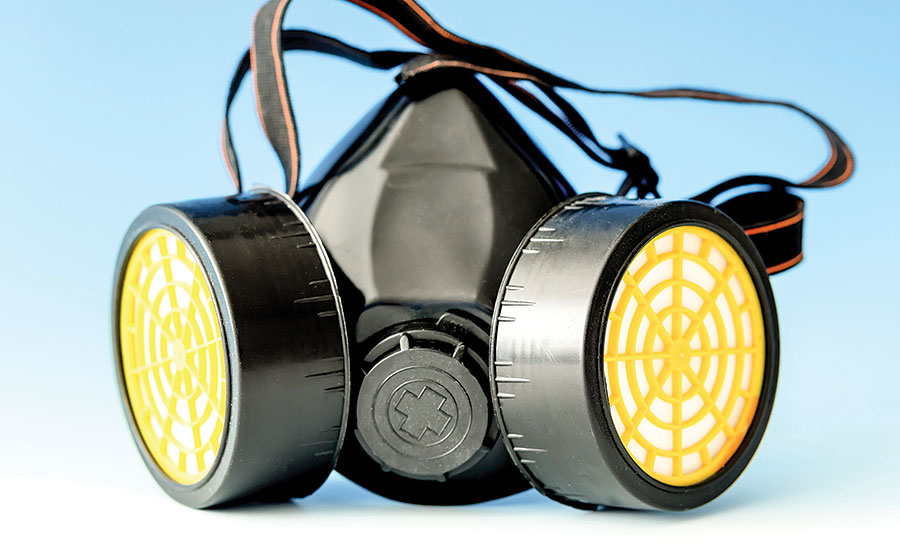OSHA’s respiratory protection standard 1910.0134 was the fourth most-frequently cited rule in fiscal year 2014, a ranking which reflects the importance of respirators among the types of protective equipment for workers who must perform tasks in hazardous environments.
The standard requires engineering control measures as the first line of defense in preventing harmful dusts, fogs, fumes, mists, gases, smokes, sprays, or vapors from entering the workplace atmosphere. But “when effective engineering controls are not feasible, or while they are being instituted, appropriate respirators shall be used.”1
It is not enough to simply supply workers with respirators. “In any workplace where respirators are necessary to protect the health of the employee or whenever respirators are required by the employer, the employer shall establish and implement a written respiratory protection program with worksite-specific procedures. The program shall be updated as necessary to reflect those changes in workplace conditions that affect respirator use.”1
Respirators prevent workers from inhaling dangerous substances by either filtering particles from the air, chemically cleaning (purifying) the air, or supplying clean air from an outside source. They range from simple particulate respirators to more complex Powered Air-Purifying Respirators (PAPR) and Self-Contained Breathing Apparatus (SCBA). Selecting the right kind of respirator is vital. It requires an assessment of airborne concentrations and of all the workplace operations, processes or environments that may create a respiratory hazard – which should be done by experienced safety personnel or by an industrial hygienist.
Why are an estimated five million workers required to wear respirators in 1.3 million U.S. workplaces? Respiratory hazards may cause cancer, lung impairment, diseases, or death. OSHA says that compliance with its Respiratory Protection Standard could avert hundreds of deaths and thousands of illnesses annually.2
$2 million+ in penalties
OSHA compliance officers issued a total of 3,681 respiratory protection-related citations in FY 2014 during 1,767 inspections. Total penalties assessed were $2,230,370,
Fabricated Metal Product Manufacturing was the most-cited industry, with 237 inspections yielding 528 citations and $297,545 in penalties. Specialty Trade Contractors had 490 citations from 251 inspections, with $313,178 in penalties.
Repair and Maintenance – which covers many types of workplaces – had 276 citations from 118 inspections ($119,762). Transportation Equipment Manufacturing earned 196 citations from 93 inspections ($172,120). Nonmetallic Mineral Product Manufacturing had 195 citations (105, $147,200); Machinery Manufacturing had 189 (78, $85,736) and Chemical Manufacturing had 152 (64, $143,688).
Rounding out the top ten list: Construction of Buildings, with 123 citations (55 inspections, $56,963) in penalties; Merchant Wholesalers, Durable Goods (122, 53, $44,677) and Furniture and Related Product Manufacturing (106, 46, $40,755).
An inspection3 earlier this year of a dry wall manufacturer’s facility found that workers were being exposed to excessive silica and airborne dust in the manufacturing of dry wall compound – which could lead to the development of disabling and sometimes fatal lung diseases, including silicosis and lung cancer. Among the serious safety violations found at Total Wall, Inc.: the lack of a respiratory protection program and failure to identify and evaluate the respiratory hazards in the workplace; conduct a medical evaluation of an employee’s ability to use a respirator prior to fit testing; and train employees in how to use a respirator.
Workers and employers who are using respiratory protection for the first time can find helpful information in the OSHA Bulletin, General Respiratory Protection Guidance for Employers and Workers.4
1 www.osha.gov/pls/oshaweb/owadisp.show_document?p_table=STANDARDS&p_id=12716
2 www.osha.gov/SLTC/respiratoryprotection/index.html
3 www.osha.gov/pls/oshaweb/owadisp.show_document?p_table=NEWS_RELEASES&p_id=28719
4 www.osha.gov/dts/shib/respiratory_protection_bulletin_2011.html


